1. Good drainage. Preventing water from collecting on the roof is the first step to keeping it out of your building.
2. Safe but limited roof access. Access is a double-sided sword. You need good access to the roof so you can conduct inspections and take care of repairs, but if it’s too easy to get onto the roof, people who don’t belong there could cause excess roof strain. You need control over who is able to get onto the roof. If your roof has interior access, consider locking the door so that people can’t step out on a whim to smoke cigarettes. For roofs with exterior access, use a removable ladder or make an installed ladder retractable or lockable.
Also make sure you don’t have fences or other nearby obstacles that people can use for roof access. I especially see this happen at schools – kids would rather play on the rooftop than on the grounds surrounding it.
3. Proper equipment clearance. NRCA has guidelines on how high equipment stands should be to provide enough clearance to let tradespeople get under the equipment for maintenance and repairs. The larger the equipment, the higher the stand needs to be.
Keys to Roofing Maintenance
How to keep your roof leak-free. Read More >>
4. Space around penetrations. Any penetration through the roof needs sufficient clearance for repairs. Penetrations should be at least a foot from roof edges, other penetrations and any other items on the rooftop.
5. Water barriers under expansion joints. This is a simple, inexpensive fix for which you could use 6-mil polyethylene or scraps of single-ply membrane. The point is to prevent water that leaks through the joints from getting into the building. Another place to install these is around the coping.
6. Limited legs at the corners. Too often, people take 8- to 10-foot lengths of metal and create long runs. Because metal expands and contracts so much, if you limit the legs in the corners to only a foot or so, you can reduce the stress on the corners.
7. Two-piece counterflashing on parapet walls. If your roof membrane has a 20- to 25-year life, you’ll have to tend to the flashings several times. Staying in a building for 50-75 years means you’ll put two to three roofs on and every one of them will have to be reflashed at some point. A two-piece counterflashing on the parapet is easy to incorporate during your next reroofing project and will save you some headaches.
8. Pipe support systems. A block of wood lying on top of a membrane is not a proper pipe support. It rubs back and forth, tears the membrane and causes endless problems. I refer to well-designed pipe supports as “UFO details” – you hear about them but never see them.
